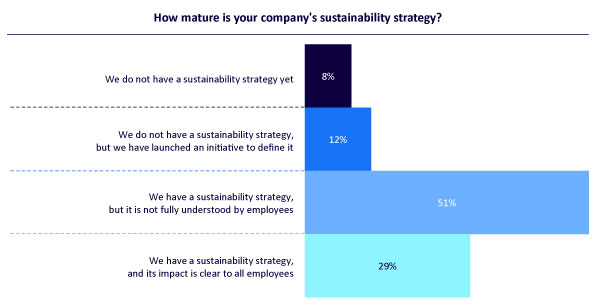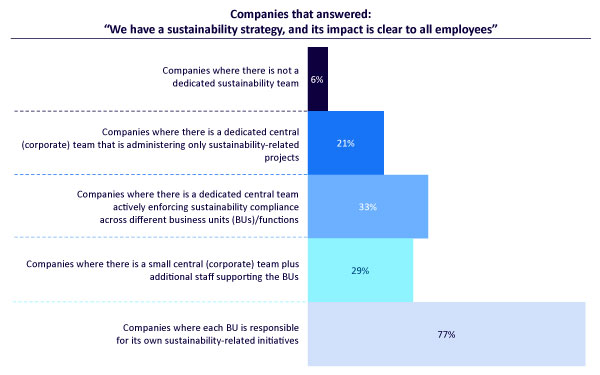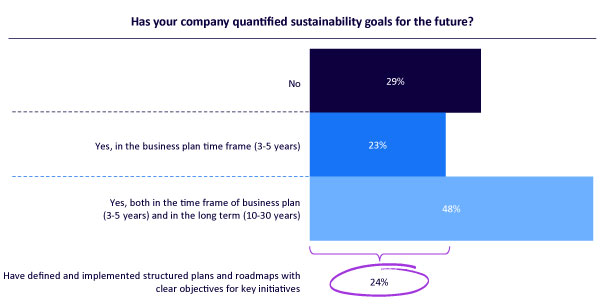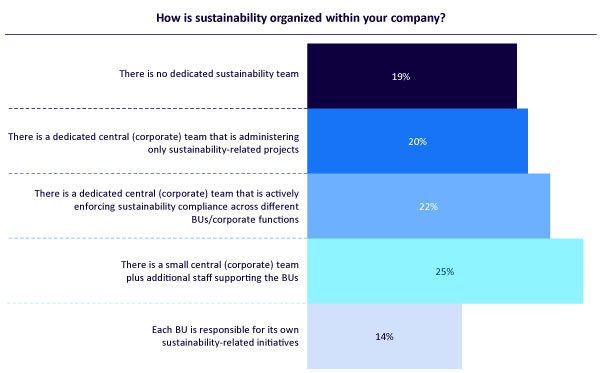SUSTAINABILITY EXECUTIVE UPDATE VOL. 1, NO. 4

The State of Sustainability in Organizations
Driven by public and stakeholder pressure, sustainability has risen to the top of the business agenda for CEOs in all sectors. Demonstrating the focus from investors, nearly a third of shareholders (32%) supported social and environmental proposals at US company shareholder meetings in 2021 — up from 21% in 2017, according to the Sustainable Investments Institute. The Securities and Exchange Commission (SEC) has proposed new rules that mandate that all publicly traded companies disclose climate change risks in their regular filings. Similar regulatory and reporting initiatives are in place in the EU and Asian countries.
This has led to a wealth of commitments covering reporting against sustainability metrics and setting targets for improvement. For example, 45 of the 50 largest companies in the S&P 500 Index now report their carbon disclosures to the CDP (formerly the Carbon Disclosure Project) and 31 have committed to achieving net-zero carbon emissions.
While acting on sustainability initially was perceived as part of being a “good corporate citizen,” it is now evident that properly adopting sustainability within an organization can deliver both top-line and bottom-line benefits, leading to higher shareholder returns. Among benefits leaders in sustainability have experienced recently are faster growth, reduced cost of debt financing, lower employee turnover, and increased resilience in the face of business risks and market challenges, as well as improved corporate reputation and branding.
However, the road to introduce and implement sustainability within an organization is certainly not without challenges. Many companies have made commitments — but are they able to deliver on them successfully?
The ADL study went beyond the buzz to see what is actually being put in place — and what is not. The headline findings are of a business world in transition. On the positive side, companies see the benefits of sustainability across multiple dimensions and how it increases their attractiveness to customers, employees, and investors. However, the majority have yet to see a direct impact on financial results. This is due to a disconnect between business operations and sustainability, with many companies unable to link sustainability performance to financial or innovation metrics and reporting systems. Only 40% of respondents apply any externalities/social ROI or creating shared value evaluation models when making business and strategic decisions.
Despite understanding the benefits, a fifth of companies (20%) still do not have a sustainability strategy in place — and less than 30% believe the impact of that strategy is clear to all employees (see Figure 1). The majority are struggling to embed sustainability within the organization, and it is thus currently disconnected from staff, strategy, and operations.

This failure to take meaningful action and embed sustainability at the center of the organization does not only cause potential environmental and social harm; it also holds back business performance.
Understanding the Challenges to Effective Business Sustainability
Achieving sustainability is not a straightforward task. In today’s complex value chains, being able to move beyond making commitments to successfully implement sustainability programs requires a transformative approach based on overcoming six key challenges, described below.
1. Sustainability Strategy Not Understood
Most sustainability strategies are not yet mature when it comes to being understood by those that are on the front line of delivering them: the employees. Strategies are either not in place or are not understood by staff within 71% of responding companies. Even among those with a strategy in place, nearly two-thirds admit its impact and direction are not clear to employees.
Three factors stand out as causes for this gap: a lack of commonly understood internal sustainability standards, poor communication, and lack of incentives.
Unclear Internal Standards Undermine Decision Making
Currently, many organizations suffer from a lack of commonly understood internal standards when it comes to measuring sustainability performance. Companies need to clearly articulate what they are going to measure, what the KPIs are, and what “good enough” performance looks like for the organization. If this is unclear, employees, particularly those who are not in central sustainability teams, will not be able to make informed decisions in their day-to-day activities and will not see how they can contribute to overall sustainability targets.
Poor Communication Holds Back Understanding
More than three-quarters (77%) of responding organizations have not communicated their strategy at all, have communicated irregularly, or have shared it only with specific organizational levels. Becoming sustainable is a major cultural change for many organizations, meaning that it requires an ongoing dialogue with staff to ensure they understand objectives, their role in achieving them, and can measure progress toward success.
Interestingly, alignment is much more prevalent when organizations have made individual business units (BUs) responsible for their own sustainability initiatives (see Figure 2). Over three-quarters (77%) of this group said their employees understood their sustainability strategy. However, the way sustainability is organized needs to be well-defined and anchored into the wider organization. It needs to fit with how the organization operates and governs itself. Otherwise, activities will not be aligned, particularly around standards on what is “good” performance (i.e., which indicators to follow and what thresholds need to be met) and how management incentives reinforce the right behaviors. It is possible that BU activities could even counteract or undermine corporate sustainability initiatives.

Two-Thirds Do Not Incentivize Sustainability
Along with effective communication and strong governance structures that anchor sustainability in the organization, linking sustainability progress to incentives is proven to change behavior and drive change. This starts at the top and then cascades down into the objectives of all staff. However, two-thirds (65%) of surveyed companies do not currently link senior management incentives to sustainability performance.
Fixing the issues of communication and incentives is at the heart of engaging employees at all levels with sustainability, ensuring they both understand the strategy and are enthusiastically involved in its execution.
2. Failure to Change Business Models
Sustainability is an opportunity for organizations, but to be successful it must be central to both new and existing business models. Simply seeing it as another cost to be borne or regulation to be met will not deliver its real, transformative benefits.
However, just 8% of respondents say that they have changed their business model due to sustainability. Most organizations have simply tweaked existing ways of doing business. While some businesses (such as in digital industries) may not need to change their models, the majority (59%) of survey respondents are in sectors such as automotive, energy, chemicals, engineering, and transport that are heavily impacted by sustainability, and are required to make significant changes. This lack of a profound systemic change further demonstrates the current lack of maturity around sustainability. To gain its advantages, organizations must change models and ways of operating, often dramatically, rather than continuing business as usual with minor modifications. Sustainability targets, such as around carbon emissions, cannot be met without starting to take major action now.
3. No Clear Balance Between Short- & Long-Term Plans
For sustainability strategies to deliver, it is vital to set a mix of long-term (20, 30, or 40 years) and short-term goals. Simply putting a stake in the ground and saying you will achieve net-zero by 2050 is not enough — you need a plan that maps the short-term steps that will get you there. It is critical to start now with a concrete strategy and detailed plans and to involve your wider value chain. For example, in areas such as carbon, emissions are cumulative, meaning companies need to make a big effort now to invert the trend and start to lower emissions if they are to hit science-based targets by 2050.
Insufficient Detail & Scope in Planning
A third of responding organizations have not yet put long-term plans and goals in place, with a further third defining plans but not yet deploying them. Despite the need to balance long and short time frames, less than half (48%) of organizations have considered both when creating business plans (see Figure 3). Even here there is a worrying lack of detail — just half of these (24%) have defined and implemented structured long-term plans with clear objectives for every initiative.

This echoes other research findings. For example, the “Corporate Climate Responsibility Monitor 2022,” from the New Climate Institute and Carbon Market Watch reports that headline pledges for emissions reductions are often ambiguous or limited, with just 12% of companies surveyed clearly committing to deep decarbonization of over 90% of their full value chain emissions by their set target dates.
Failure to Set Challenging Goals for GHG & Carbon Emissions Reduction
Achieving net-zero for greenhouse gas (GHG) emissions should be a clear first target for most businesses. Yet 43% of surveyed companies have not yet set a strategy.
Targets vary. While many are long-term, reaching up to 2050, the nature of science-based targets means they need to be backed up by short- and medium-term plans to show how companies will achieve their overall net-zero aims. For example, companies that adopt the Science-Based Target initiative (SBTi) Net-Zero Standard are required to specify both short/medium-term and long-term science-based targets.
To meet their targets, organizations need to start by estimating their current GHG emissions. This is challenging for most industries as those emissions occur across their value chain, upstream and downstream of company production facilities. Therefore, it is crucial to involve the wider ecosystem (and its emissions) in improving performance, as we discuss below.
4. Not Seeking Sustainability Partners Across Wider Ecosystems
Given its interconnected nature, sustainability requires an ecosystem approach. To unlock the opportunities it brings, organizations must move beyond traditional partners. The ADL survey reveals increasing collaboration between organizations and an expanding range of stakeholders. Most sustainability collaboration remains with existing partners (81%), although a growing number of organizations now collaborate with universities/R&D groups and downstream supply chain partners/end customers. Organizations need to broaden their horizons, such as by cooperating with technology companies and data providers to bring in new thinking and ideas to meet sustainability commitments.
Slow Progress on Embracing the Circular Economy
Research from Material Economics identifies a strong potential for reducing emissions by adopting circularity. However, the vast majority of companies are not yet embracing these opportunities, instead taking a linear approach that does not have concrete circularity initiatives or targets.
5. Wide Range of Governance Hampers Control
Successful change requires sufficient resources, accurate data, and strong governance to ensure that the entire organization, at every level, moves in the same direction, speaks the same language, and shares a collective understanding of goals. It is vital that organizations define and measure standards across the business, with everyone clear on what “good” looks like, if governance is to be effectively embedded within daily activities.
There is no single approach organizations take to governance models (see Figure 4). What is vital, however, is that sustainability governance is organically embedded in the existing corporate organization and structure with some level of corporate control or oversight. Targets and objectives must be cascaded down (and validated bottom-up) to meet corporate objectives.

6. Inability to Track Performance with the Right Tools
Clearly, organizations need to be able to effectively track and demonstrate progress toward their commitments both internally and with external stakeholders such as investors, regulators, and customers. However, a company’s activities are complex and are continually changing, due to a variety of situations including:
-
Products and divisions can be sold.
-
New products are bought or introduced.
-
Growth in particular markets or regions impacts emissions.
-
Low-carbon products may be retired due to market changes.
-
Value chain partners can implement changes that affect a company’s emissions.
Consequently, without the ability to track performance it is difficult to understand exactly where you stand and to measure sustainability performance and progress against targets. This will become much more important in the near term when regulators mandate greater transparency around climate change–related emissions and risks. Yet, in this area companies are held back by a lack of flexible, usable measurement tools. In fact, among respondents, 43% are not confident that they can track performance, while a further 47% have tools but feel they are too labor-intensive to deliver full value.
The Business Impact of Poor Measurement & Reporting
There is a growing volume of investment capital looking for sustainable investment opportunities. Attracting this requires organizations to be able to demonstrate their sustainable credentials and progress toward achieving commitments. Yet sustainability performance reporting remains the poor cousin of financial reporting. Just 17% of surveyed organizations believe that the two areas share the same rigor, while only 13% integrate sustainability and financial reporting into the same document.
Often this lack of rigor comes from companies being reactive rather than proactive. They begin with the goal of creating a sustainability report rather than starting with the bigger objective of setting a strategy and governance that will allow the proper steering of sustainability inside the organization. As a result, these companies fail to articulate their strategies and develop the necessary confidence around their sustainability initiatives, which are essential in discussions with investors. Of respondents, 30% say they do not discuss sustainability with investors at all, and only 22% are using their performance metrics to attract green investors. Essentially, 78% of the organizations are not fully exploiting the growing availability of green investment and the better terms it offers.
Part II of this Update series will set out key recommendations to unlock the benefits of sustainability by adopting an ecosystem approach, integrating sustainability reporting, redefining culture, and focusing on innovation.






